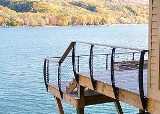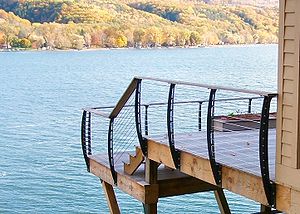
Cable railings
Encyclopedia

Spindle (furniture)
A Spindle, in furniture, is an cylindrically symmetric shaft, usually made of wood. A spindle is usually made of a single piece of wood and typically has decoration fashioned by hand or with a lathe...
s, glass
Glass
Glass is an amorphous solid material. Glasses are typically brittle and optically transparent.The most familiar type of glass, used for centuries in windows and drinking vessels, is soda-lime glass, composed of about 75% silica plus Na2O, CaO, and several minor additives...
, mesh etc. for infill
Infill
Infill in its broadest meaning is material that fills in an otherwise unoccupied space. The term is commonly used in association with construction techniques such as wattle and daub, and civil engineering activities such as land reclamation.-Construction:...
.
Uses
This type of railing is favored in areas where view of the landscape or ocean would be impaired by other types of railings. Wood railings with spindles, for example, can obstruct views where as cables can nearly disappear. Glass railing provide a similar function however cable railings are replacing glass panel railings due to their lower maintenance and reduced sun glareGlare
Glare may refer to:* Glare is difficulty seeing in the presence of very bright light* A glare is a facial expression of squinted eyes and look of contempt* A call collision in telecommunications* GLARE, an advanced aerospace material...
.Cable railings were initially favored for contemporary architecture however they have become popular on all types of homes due to the variety of cable rail post styles now available.
Post construction
Cable railing requires very rigid frames compared to many other types of railings due to the forces applied to the end posts by tensioning the cables. Cables must be tensioned to provide a rigid as possible condition to satisfy building code requirements. Common frame types are constructed of steel, stainless steelStainless steel
In metallurgy, stainless steel, also known as inox steel or inox from French "inoxydable", is defined as a steel alloy with a minimum of 10.5 or 11% chromium content by mass....
, extruded aluminum or wood.
Cables and tensioning
Cable is very strong in tensile strength and is a suitable in-fill material for a railing ("guard" in ICC codes). Typical diameters are 1/8", 3/16" for residential and 3/16" and 1/4" for commercial applications. There are many different types cable and strand (also referred to as wire rope). Cable and strand is available in galvanized carbon steel, type 304 stainless steel, or the highly corrosion resistant, type 316 stainless steel (best for coastal areas).The most common cable construction is 1-19 type construction strand (see illustration). This type of stainless strand is designed not to stretch like other constructions and has long been used for yacht stays and guy wires and has proven outdoor durability an strength.Cable flexibility
Cable flexibility is an important consideration in designing a cable railing. The old UBC (Uniform Building Code) and newer ICC (IBC and IRC) codes state that a 4” sphere shall not pass through any portion of a barrier on a guardrail rail. In a horizontal or vertical cable rail, the cables, once tensioned must be rigid enough to prevent deflecting enough for a 4 inch ball to pass. Factors influencing this rigidity are: the tension of the cable, intermediate posts (or cable spacers)spacing, the diameter of the cable, top rail cap material and the cable to cable spacing.Cable Tension: An incredible amount of tension is generated on the end posts when ten or more cables, each tensioned at 200-400 Ibs. over a height of 36" to 42” exists. Many people do not understand the amount of the tension applied to the posts. Poorly designed end posts will result in a railing where the cables cannot be properly tensioned without an unacceptable amount of cable deflection. End posts to which the tensioning hardware attaches must be constructed so that they will not deflect perceptively as the cables are tensioned.
Post Spacing: Intermediate posts are posts which provide mounting for the top rail and have a vertical row of holes to support the cable as it passes through them. Since the post to post spacing is a primary driver of cable rigidity, the post to post spacing is very important (typically between 36" and 42").
Cable Diameter: The next variable is the diameter of the cable. Cables can be 1/8, 3/16 or 1/4 inch diameter. The larger the diameter, the more rigid (and costly) the cable.
Top rail: Top rail material must be strong as it is being compressed by the combined cable forces. Common top cap materials are the stronger species of wood or metal. Composite lumber is not suitable.
Cable to cable spacing: Spacing of the cables vertically is critical to minimize deflection of the cables. Most manufacturers recommended maximum vertical spacing of 3-inch free opening between cables when they are installed.
All of the above factors work together to minimize the deflection of the cable to prevent a 4” sphere from passing between the cables when they are properly tensioned in a well-designed frame.

